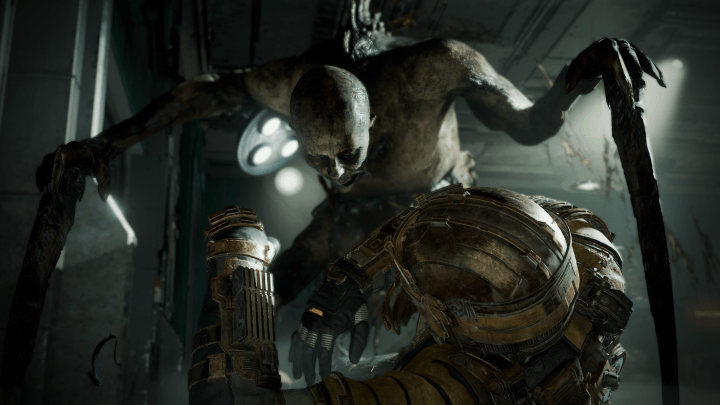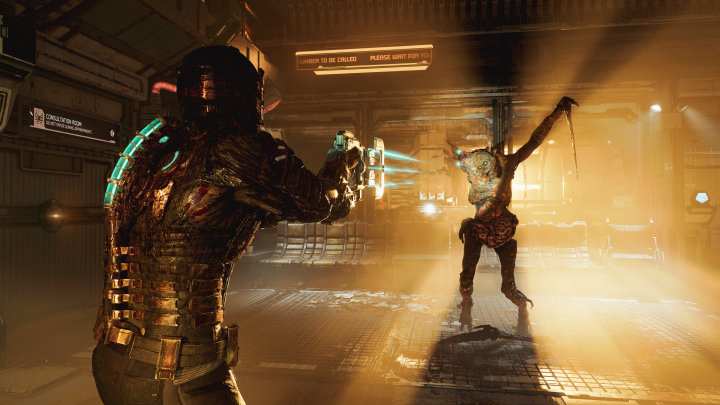





Whether it’s by coincidence or some kind of telepathic developer wavelength, the Dead Space renaissance is here. Several sci-fi horror games are in development, some of which are directly inspired by EA’s 2008 classic. Leading that charge is … well, Dead Space itself.
Developer EA Motive is rebooting the series with a ground-up remake of its first installment set to launch in January. While the studio has been transparent about the development process, we had yet to get a significant look at the project. EA finally lifted that lid in September with a press event that allowed journalists to play through the first three chapters of the game (spanning roughly four hours).
Having just played Dead Space for the first time in December, I went into my remake demo with the original very fresh in my mind. The chapters I played are incredibly faithful, preserving the more claustrophobic horror of the original while doubling down on its hyper-violence. Its main differences come from sizable tech boosts — some of which are invisible to players entirely — that make it a more immersive and less predictable return to the USG Ishimura.
Video Impressions
Bloodbath
If you’ve played Dead Space before, the remake will feel instantly familiar. From the moment Isaac Clarke made his fateful walk down the Ishimura’s ship dock, I could tell EA Motive was sticking to the script rather than going after a radical reboot. During my demo, I watched a scientist get maimed by a lurker, got dragged down a hall by a giant tentacle, and found myself locked in that damn decontamination chamber (you know the one). Even the moments that aren’t one-to-one recreations still feel the same.
Creative Director Roman Campos-Oriola notes that the EA Motive has a lot of reverence for the original, which is why it jumped at the chance to tackle the project. With that respect, the team wanted to make sure it was using technology to enhance the original, not redo it.
“It’s been like 15 years since that game has been done, and there’s been a lot of things that have changed in terms of engines, rendering, technology,” Roman tells Digital Trends. “It’s not like changing or remaking it for the sake of doing that, but it feels like there are elements that we can take from the original and actually push them even further while keeping the essence and philosophy of the original.”

From an immediate technical standpoint, the difference is clear. This version of Dead Space looks undoubtedly better with more dynamic lighting, impressive particle effects, and detailed textures — 2008 Clarke looks like a rubbery Stretch Armstrong action figure next to the new model. After a too-close encounter with a necromorph, I noticed that Clarke’s suit was drenched in blood with detailed splatters and dribbles glistening on metal and darkly caked into mesh fabric.
I especially noticed a difference when watching my footage back and comparing specific rooms on the Ishimura to the original. Take the medical bay, for instance. In the 2008 version, it’s a big square room filled with blood-stained beds in a well-lit room with a few extra highlights created by some lamps. The new version is significantly more atmospheric. A layer of haze billows above the floor, some lights eerily flicker, and sparks rain out from a frayed wire on a wall.
Intensity director
The tech boost isn’t just a matter of bumping visual fidelity — in fact, that’s the part of the demo I was least intrigued by. The grandest change is that chapters are no longer broken up by tram rides and long loading screens. There’s no loading period according to EA. The Ishimura is now walkable end to end, as the game unfolds in one continuous camera shot like God of War (2018).
There are a lot of smaller details that caught my eye too. For instance, the team has gone to much greater lengths to make the Ishimura feel like a lived-in space rather than a series of corridors. Rooms have significantly more set dressing, with some aspects even adding some environmental storytelling that gave me flashbacks to Prey (2017).

“You look at the ship and you go, this is a place where people are living, they’re working, they’re there for extended periods of time. And yet in the game, it felt a bit bare,” Mike Yazijian tells Digital Trends. “We actually imagined, like what if we lived there? What if we worked there? What would it feel like? Not a very happy place! We wanted to capture that feeling … You’re going to see all these posters that talk about the culture, the way they’re living, their values, and so on. There’s a propaganda kind of feel to it, the 1960’s era vibe.”
What’s most impressive, however, is something that’s entirely invisible to the player: the intensity director. The tool is a behind-the-scenes conductor that can dynamically change several elements of the game, potentially making a room feel completely different the second time you cross through it. It can change what enemies spawn, where they spawn, the amount of fog present, how the lights function, and much more. That adds a new layer of unpredictability to the experience that’ll keep players on their toes both during their initial playthrough and on repeat visits.
“Take the example of Chapter 2,” Campos-Oriola explains. “When you kill the captain and you come back through the elevator, now you need to reach the hangar to go to Chapter 3. That walk between the elevator from the morgue to the tram … the intensity director is playing 100%. Sometimes there’s gonna be fights, sometimes it’s going to be pitch black with whispers, sometimes all the lights are going to turn on and a lurker is going to spawn, and sometimes nothing is going to happen.”

That intricate system could solve one of the biggest challenges that horror games face. Once you understand the script, it ceases to be scary. It’s like walking through a haunted house with a map that shows exactly where every actor will pop out. The intensity director completely changes that, even between individual deaths. The first time I noticed it working, I died in a room where I had to fend off some necromorphs. When I respawned, I positioned myself near where I saw the first one spawn and waited to get the jump on it … but I was jumped from behind instead, as that first enemy spawned from a different vent. Considering that the remake looks to return the series to its horror roots, that sensation could be key in making sure that even fans who know the original front and back will be scared.
Limb from limb
The technological advancements have a strong impact on combat too, namely the series’ signature dismemberment mechanic. Like the original game, players can use their guns to hack off enemy limbs one at a time. If you can believe it, EA Motive has found a way to make that body horror puzzling even more grotesque this time around.
When you shoot a limb in Dead Space, you won’t cleanly sever it on the first shot. That’s because enemies now have extra layers of flesh and bones that you can peel back as you unload shots into them (much like the upcoming Dead Island 2). When a necromorph approaches me in a tight room, I take a shot at its leg, exposing the bone before finishing the cut with a second shot. As it crawls forward on its scythe-like arms, I launch another shot at its forearm leaving it barely clung together by some flesh. A second shot not just slashes through that, but seems to shave a bit off the side of its head in the process. Of course, I follow that up with a stomp to send any still attached limbs flying.

The ghoulish spectacle isn’t just EA Motive showing off (Campos-Oriola stresses that the team wasn’t trying to outdo the original game). The revamped flesh system better encourages players to use weapons that originally felt a little useless next to the multipurpose plasma cutter.
“It allows us to add the same type of fun gameplay experience that you had in the original with the plasma cutter and the line gun,” Campos-Oriola says. “But you have it a little bit less in the original with the pulse rifle. All the weapons that don’t cut limbs by themselves in the original … it’s still cool, but like, the plasma cutter man! But now with the layers, the pulse rifle or the force gun — even the flamethrower when you see the flesh getting charred — it’s a bit gruesome! It feels as good as the plasma cutter!”
When talking about all these technical bumps, Campos-Oriola emphasizes that it’s not that the team felt the original needed a remake. Rather, they felt it deserved one with modern advancements that would do it justice. That same thinking dictated what ideas from Dead Space 2 and 3 would carry over to the remake. Notable changes include Isaac Clarke being fully voiced by Gunner Wright (who acted as his voice starting in 2) and zero gravity sequences now allowing Isaac to freely fly rather than hopping between surfaces. Those changes are so naturally implemented that I forgot they weren’t in the original to begin with.

There’s still a little work to be done before the game’s January release, as all these technical boosts certainly don’t seem easy to juggle. The build press saw still had some notable frame rate issues and I caught enemies clipping through walls and floors during my session. That’s not a cause for concern for me, as those are some standard issues for a work-in-progress build, but it’s clear that some of those fine details may push platforms to their limits.
Dead Space seems to be hitting all the right notes so far. It doesn’t fundamentally change the original, staying true to its set pieces and story beats, but it does make high-level improvements that enhance the horror and immersion. While I’m not sure how its 2008 DNA will ultimately look next to more modern spins on the formula (like The Callisto Protocol), it’ll be a strong reminder of why developers are so eager to replicate its success 15 years later.
Dead Space launches on January 27 for Xbox Series X, PS5, and PC.
Disclosure: Digital Trends was flown to Redmond, California to preview Dead Space, with travel accommodations covered by PR agency Fortyseven Communications. This did not influence our coverage of the game.
Digital Trend, New tech, tech news, wikiHow

No comments:
Post a Comment